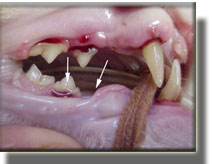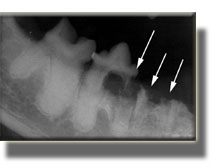Feline Tooth Resorption has many names, including Feline Odontoclastic Tooth Resorption, Feline Cavities, Neck Lesions, Cervical Erosions, Cervical Cavities, and others. Most cats over the age of five have one or more of these painful cavities at or under the gum line. If your cat has “missing teeth”, they quite likely have been lost from this process. They start as small defects in the tooth structure just under the gum line, and progress to painful invasion of the tooth by cells that gradually remove tooth structure and replace it with bone. The areas of tooth resorption commonly become visible above the gum line as fleshy pink areas of gum tissue. The nerve is frequently involved in the process, causing discomfort. Many times the weakened tooth breaks off, leaving painful retained roots in the jaw. The lesions can appear to be very small, yet can be associated with a large loss of tooth structure. Treatment usually involves extraction, as these teeth are not amenable to restoration.

After the teeth in this patient were cleaned, some reddened areas were noted along the gum line (arrows). The dental X-ray of this patient is to the right.

The arrows point to the area of the missing premolar, showing the retained roots hidden under the gums. Also visible is a large area of tooth resorption that has almost eaten through the root of the adjacent premolar.
When extracting these teeth, every effort should be made to remove all of the root structure. Some practitioners incorrectly treat these teeth by simply cutting off the visible part of the tooth, leaving the root structures in place under the gum line to be hopefully resorbed over time. This inferior form of treatment can leave painful roots in place for the rest of the cat’s life. Although this technique is occasionally appropriate, dental X-rays are needed to guide correct treatment. Can you imagine how you would feel if you had a tooth “extracted” and all they did was drill the visible part of the tooth away, leaving the roots in place? In the majority of cases, the roots of feline teeth can and should be extracted in their entirety.
